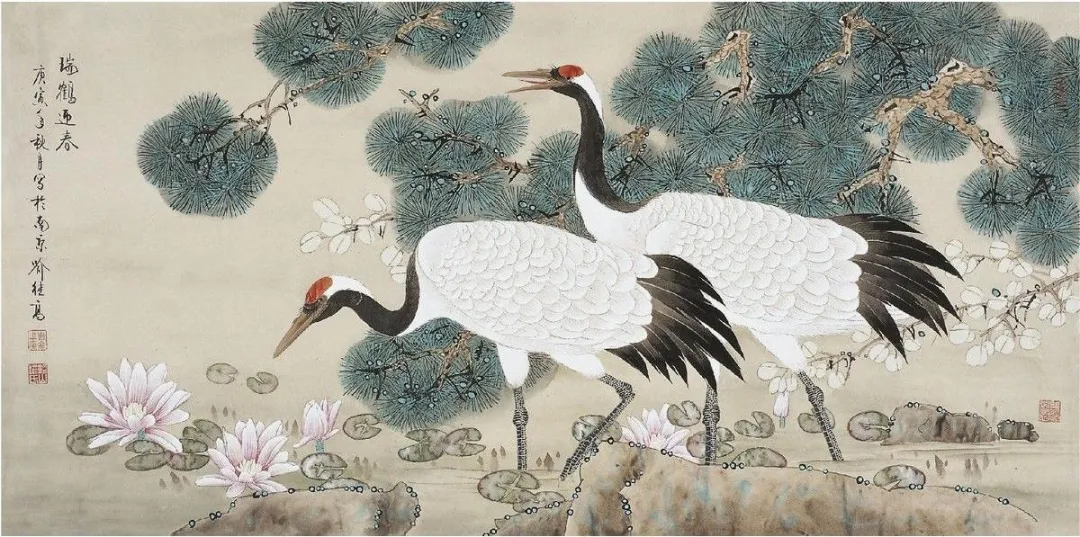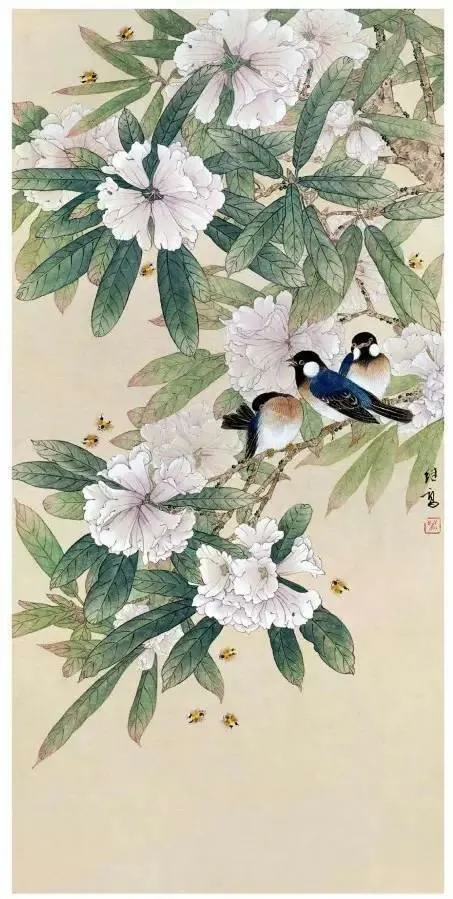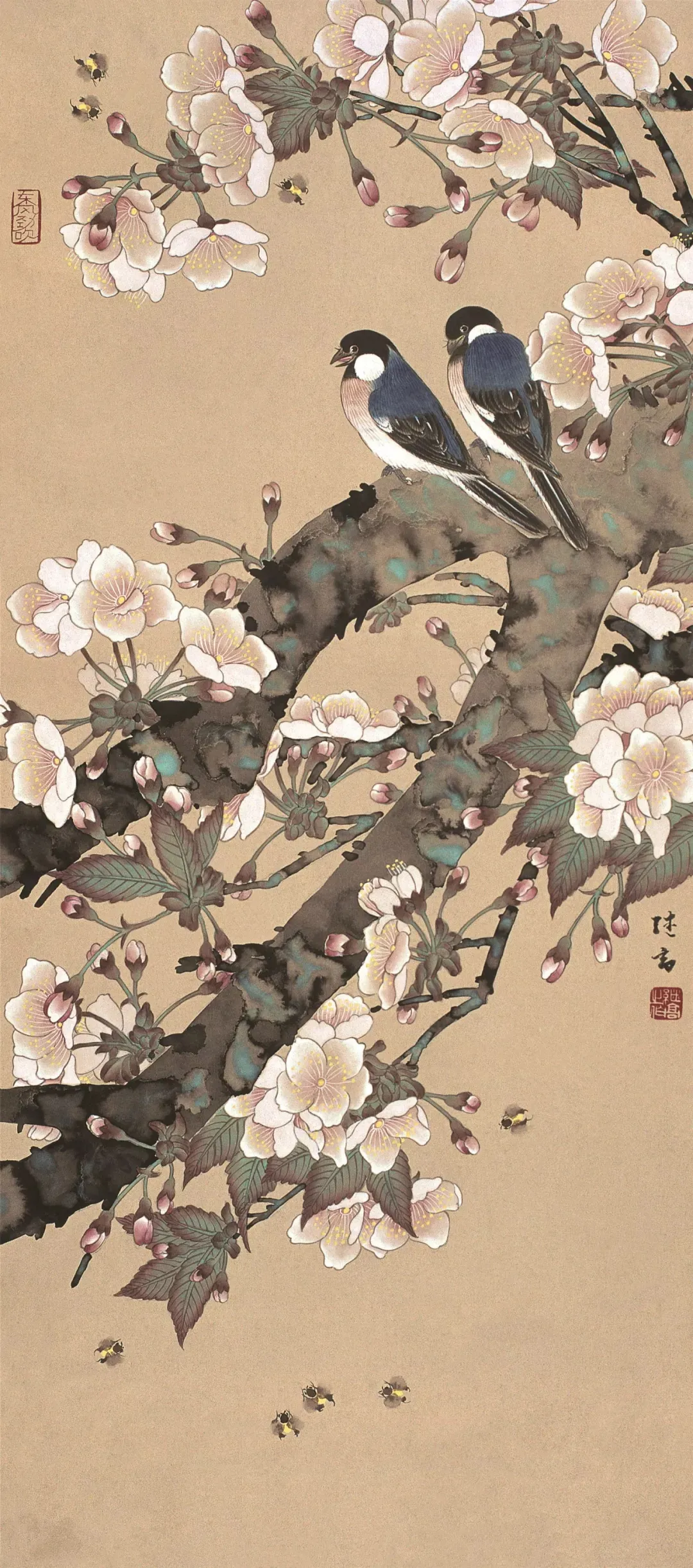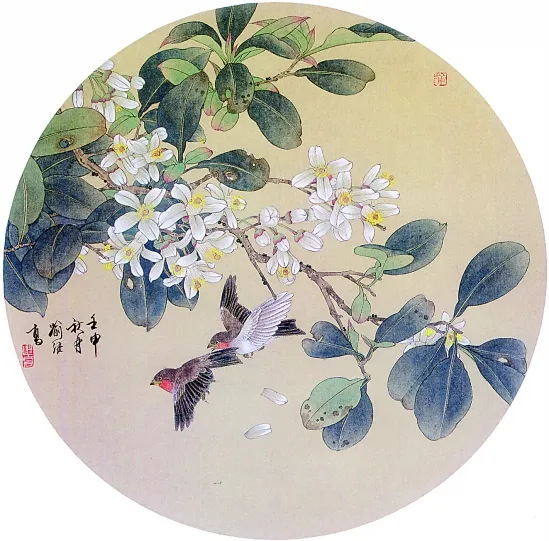喻继高,别署云岭堂,辛未年生于江苏铜山。其艺途始于苏北田野,乡土坚其志,农事育其情。家贫,少即务农,然酷爱绘事。辛卯年,刻苦攻读,入南京师范学院美术系开启艺道。彼时,得傅抱石、陈之佛二大师提携,始入工笔重彩花鸟画堂奥。
Yu Jigao, also known by his studio name Yunling Hall, was born in Xinsi Year in Tongshan, Jiangsu. His artistic path began in the fields of northern Jiangsu, where the rural life forged his determination and nurtured his love for nature. Despite his family's poverty and early involvement in farm work, his passion for painting remained undiminished. In the Xinmao Year, through hard work, he was admitted to the Fine Arts Department of Nanjing Normal University, thus beginning his artistic journey. During this time, he received guidance from masters Fu Baoshi and Chen Zhifo, entering the realm of meticulous bird-and-flower painting.

喻继高艺途,与琼瑶、傅抱石相识,实乃妙缘天成。时喻继高因病卧榻,偶翻喻仲林画集,见其中注释多误。心有所不忍,遂致书出版社,望再版时审慎改正。未料此画集乃琼瑶与其夫为纪念喻仲林而作,缘琼瑶曾受业于喻仲林。此事牵动琼瑶情怀,遂通电喻继高。
琼瑶时已著书四十一部,心觉疲惫,欲寻转机。忆往昔随喻仲林习画,一载光阴最为欢愉。然时运不济,艺事未竟,喻仲林遽然长逝。此后,琼瑶心系师恩,适逢拍摄《青青河边草》,下榻金陵,意欲拜谒喻继高。喻继高感其真诚,乃作《琼花摇曳笑春风》一画,寄以深意。
In the course of Yu Jigao's artistic journey, his acquaintance with Qiong Yao and Fu Baoshi was indeed a serendipitous fate. At a time when Yu Jigao was bedridden due to illness, he happened to browse through a collection of paintings by Yu Zhonglin, only to find numerous errors in the annotations. Unable to overlook these mistakes, he wrote to the publisher, urging them to carefully amend them in future editions. Little did he know that this collection was compiled by Qiong Yao and her husband in memory of Yu Zhonglin, as Qiong Yao had once been his student. This discovery deeply moved Qiong Yao, prompting her to contact Yu Jigao.
At that time, Qiong Yao had already written forty-one novels, but she felt exhausted and sought a change. She fondly recalled the days when she studied painting under Yu Zhonglin; that year was the most joyful time of her life. However, her studies were cut short when Yu Zhonglin suddenly passed away. Later, as she prepared to film "Green Grass by the River" and lodged at the Jinling Hotel, she longed to visit Yu Jigao to pay her respects. Touched by her sincerity, Yu Jigao created a painting titled "Qiong Flower Swaying in the Spring Breeze," to express his heartfelt sentiment.

癸巳之岁,喻继高忆随傅抱石学画往事,感慨系之。初见之时,傅先生为南大艺术系教授,亲授画艺于梅庵。先生身着灰衫,执陈之佛画册,目光深邃,神采奕奕。忽问弟子:“古今画史,谁可言其大者?”新生皆默然低首,未有应答。先生微笑曰:“白纸新图,吾必尽教。”言辞间,满怀期待,弟子闻之肃然。
傅先生知喻继高家贫,时赠纸墨,以助其学。写生之时,手指梅花,亲教画法。更破例许喻继高入其画室,画室简朴幽静,别有洞天。喻继高得此礼遇,铭感于心。
乙未之冬,喻继高被召赴文艺大会,携画具应命。会上名家齐集,陈之佛先生先绘腊梅,傅抱石忽命喻继高续画。喻继高敬畏之中,仍敢下笔,绘一艳红山茶。傅先生见之,微笑颔首,亦为添石笋一根。蒋仁画八哥,胡小石题字“迎春图”。此画装裱后悬于政协礼堂,文革时失踪多年,后闻南京博物院藏之,喻继高特赴观览,留影纪念,以此为师生情谊之见证。
In the year of Guisi, Yu Jigao recalled his time learning painting under Fu Baoshi, feeling a deep sense of nostalgia. When they first met, Fu Baoshi was a professor at Nanjing University's Art Department, personally teaching painting at the Meian studio. Dressed in a gray robe, holding a painting book by Chen Zhifo, his gaze was profound and his presence commanding. Suddenly, he asked his students, "Who among you can name the great masters of painting throughout history?" The newly enrolled students, including Yu Jigao, remained silent, heads bowed. Fu Baoshi, however, smiled and said, "A blank canvas can yield the freshest and most beautiful paintings; I shall teach you with all my heart." His words were filled with anticipation, which left the students awestruck.
Fu Baoshi knew of Yu Jigao's modest background and often gifted him paper and ink to support his studies. During field studies, Fu Baoshi personally guided him on how to capture the essence of plum blossoms in his art. He even broke his usual rule and allowed Yu Jigao to enter his private studio, which, though simple and quiet, possessed an extraordinary ambiance. Yu Jigao was deeply moved by this exceptional treatment, carrying its significance in his heart.
In the winter of Yiwei, Yu Jigao was summoned to attend a literary and art conference, bringing his painting tools as required. The gathering was attended by prominent artists, with Chen Zhifo first painting a branch of plum blossoms. Suddenly, Fu Baoshi instructed Yu Jigao to continue the painting. Despite his reverence, Yu Jigao bravely took up the brush and painted a vibrant red camellia. Fu Baoshi, pleased, nodded with a smile and added a stone peak to the composition. Jiang Ren added three mynah birds, and Hu Xiaoshi inscribed the title "Spring Welcoming." This painting, once mounted, hung in the council hall but was lost during the Cultural Revolution. Many years later, it was discovered to be in the collection of the Nanjing Museum. Yu Jigao visited the museum to view the painting and took a photograph as a lasting memento of the bond between teacher and student.

喻继高之作,近师陈之佛,远祖五代两宋,尤以造化为师,熔铸生活之情。所绘非奇花异草,皆日常花果虫鸟,予人朴实亲近之感。其画无古代院体之恬淡幽远,乃充满新时代之诗情与生机。繁盛、充盈、丰实、欢乐,光彩照人,典雅秀丽,是其工笔重彩花鸟画之基调。观其画,如聆华彩乐章,身临自然之怀,唤起人们对生活与劳动之热爱。
花鸟画于中国画史,自装饰至独立,历经演变,宋代臻于鼎盛。喻继高之艺探,肇基于此丰厚传统。乙未岁卒于南京师范学院,承傅抱石、陈之佛教益,得刘开渠、李可染指点。五十余载艺途,屡展海内外,著作画集多部。其花鸟画,继宋代院体雅致,汲民间艺术之精,成独特“继高式”风格。
Yu Jigao's works draw from Chen Zhifo's teachings and trace back to the Five Dynasties and Song Dynasty, particularly taking nature as his teacher, blending it with personal life experiences. He does not depict rare exotic plants but common flowers, fruits, insects, and birds, giving a sense of simplicity and closeness. His paintings lack the serene and distant feel of ancient court paintings, instead bursting with the poetic vigor and vitality of the new era. Flourishing, full, rich, joyful, radiant, elegant, and beautiful describe the tone and style of his meticulous bird-and-flower paintings. Viewing his works is like listening to a symphony, immersing in nature, and evoking a love for life and labor.
In the history of Chinese painting, bird-and-flower painting evolved from decorative to independent art forms, reaching its peak during the Song Dynasty. Yu Jigao's artistic exploration is based on this rich tradition. In the Yiwei Year, he graduated from Nanjing Normal University, benefiting from the teachings of Fu Baoshi and Chen Zhifo, and the guidance of Liu Kaiqu and Li Keran. Over fifty years of his artistic career, his works have been exhibited nationally and internationally, and he has published numerous painting collections. His bird-and-flower paintings inherit the elegance of the Song court style while incorporating the essence of folk art, forming his unique "Ji Gao Style."

喻氏重传统,艺事稳健,风格鲜明。画作兼有宋院体之风,融民间艺术之趣,广受众人喜爱。其作品不止显自然之形,亦蕴时代之血脉与人文情怀。喻氏之艺语,分明画家之风格,显艺术高下。幼时农村生活,作品流露泥土气息与自然深情。其画具形具神,观者如闻花香,听鸟鸣,沐阳光。
在画理处置上,喻继高深谙艺妙。其构图严谨,用笔工细,设色明丽,主次分明,浑然天成。历多年探索,逐成自家风格,注时代血脉于寻常花木飞禽,使画面生机盎然,洋溢奋进之力。其作不仅写实自然,亦讴歌生活,咏叹美与爱,唤起人们热爱生活、劳动之情。
“雅俗共赏”乃喻继高工笔花鸟画一大特点。其创作旨在为人民添美感,画作出版并展于海外,动人心弦。其成就于内容与形式之突破与创新,既承传统,亦融自家新意。画作构图严谨,用笔工细,设色明丽,清新典雅,别开新境。
喻继高之笔墨,既显传承痕迹,亦纳新时代情感。于中国画内在艺术规矩中,探其自道,以思想技巧化自然之美,丹青妙笔,绘载体上,作品生机盎然,予人朴实亲近之感,显时代与寓意。
Yu emphasizes tradition, with a steady and distinct artistic style. His works combine the elegance of the Song court style with the charm of folk art, widely appreciated by the public. His paintings not only display the forms of nature but also embody the spirit of the times and humanistic feelings. Yu's artistic language distinctly marks the artist's style and artistic level. His early life in the countryside imparts a rustic charm and deep affection for nature in his works. His paintings possess both form and spirit, allowing viewers to seemingly smell the flowers, hear the birds, and feel the sunlight.
In handling his paintings, Yu deeply understands artistic subtleties. His compositions are rigorous, his brushwork meticulous, his colors bright, with clear primary and secondary elements, creating a natural harmony. Through years of exploration, he developed his own style, infusing the vitality of the times into common flowers, plants, and birds, making his paintings vibrant and full of life. His works not only realistically depict nature but also celebrate life, extolling beauty and love, evoking a passion for life and labor in viewers.
"Enjoyable by both refined and common people" is a significant characteristic of Yu Jigao's meticulous bird-and-flower paintings. His creations aim to add beauty to people's lives, with his works published and exhibited abroad, touching the hearts of many. His achievements lie in his breakthroughs and innovations in both content and form, inheriting tradition while incorporating his own new ideas. His compositions are rigorous, brushwork meticulous, colors bright, creating a fresh and elegant new realm.
Yu Jigao's brushwork reveals traces of tradition and embraces contemporary emotions. Within the inherent artistic principles of Chinese painting, he explores his own path, transforming the beauty of nature with thought and technique, vividly depicting it on the canvas. His works are full of vitality, giving a sense of simplicity and closeness, highlighting the spirit of the times and its meanings.

从艺七十余载,喻继高恒守工笔花鸟画之探。其作传中华民族之美,爱自然、生活与和平,愿此美术传播四海,使工笔画更繁荣。其艺语表达自然生趣、天趣、意趣,于花鸟画界独树一帜,成就斐然,在中国花鸟画史上留浓墨重彩一页。
喻继高深谙“增一分则长,减一分则短”之理,表现适度,画面气度平和,雍容沉静,色彩明亮,含蕴淡雅。身心融自然,参与造化,天人合一,将对宇宙、自然、人生之感倾泻于画上。其作不仅为艺术表达,亦为情感寄托,感染众多观者。
With over seventy years in his artistic career, Yu Jigao has persistently explored meticulous bird-and-flower painting. His works convey the beauty of the Chinese nation, the love for nature, life, and peace, hoping to spread this art worldwide and make meticulous painting more prosperous. His artistic language expresses the charm of nature, heavenly beauty, and artistic interest, establishing a unique position in the bird-and-flower painting realm with remarkable achievements, leaving a bright mark in the history of Chinese bird-and-flower painting.
Yu Jigao deeply understands the principle of "adding one point is too long, subtracting one point is too short," achieving a balanced expression. His paintings exude calmness and grace, with bright yet subtly elegant colors. He immerses himself in nature, participating in creation, achieving harmony between man and nature, pouring his feelings about the universe, nature, and life onto the canvas. His works are not only artistic expressions but also emotional outlets, touching many viewers.

艺术之道,取法无尽,思悟无穷。喻继高数十年探艺,终得自我,创自家艺术语言。其作非仅描绘自然,更讴歌生活,咏叹美与爱,唤起人们热爱生活、劳动之情。在中国花鸟画史上,留下光辉篇章,成一代大家。
The path of art is endless in learning and limitless in contemplation. After decades of artistic exploration, Yu Jigao ultimately found himself and created his own artistic language. His works not only depict nature but also celebrate life, extolling beauty and love, evoking people's passion for life and labor. He has left a shining chapter in the history of Chinese bird-and-flower painting, becoming a master of his generation.
责任编辑:苗君